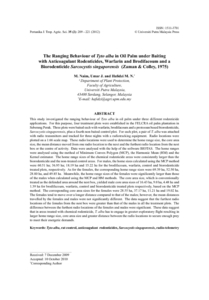Citation
Mohd. Naim, and J., Umar and Mohd Noor, Hafidzi
(2012)
The ranging behaviour of Tyto alba in oil palm under baiting with anticoagulant rodenticides, warfarin and brodifacoum and a biorodenticide Sarcocystis singaporensis (Zaman & Colley, 1975).
Pertanika Journal of Tropical Agricultural Science, 35 (2).
pp. 209-221.
ISSN 1511-3701; ESSN: 2231-8542
Abstract
This study investigated the ranging behaviour of Tyto alba in oil palm under three different rodenticide applications. For this purpose, four treatment plots were established in the FELCRA oil palm plantation in Seberang Perak. Three plots were baited each with warfarin, brodifacoum and a protozoan based biorodenticide, Sarcocystis singaporensis, plus a fourth non-baited control plot. For each plot, a pair of T. alba was attached with radio transmitters and tracked for three nights with a radiotracking equipment. Radio locations were plotted on a 1:66 scale map. These radio locations were used to determine the home range size, the core area size, the mean distance moved from one radio location to the next and the furthest radio location from the nest box or the centre of activity. Data were analysed with the help of the software BIOTAS. The home ranges were analysed using the method of Minimum Convex Polygon (MCP), the Harmonic Mean (HM) and the Kernel estimator. The home range sizes of the chemical rodenticide areas were consistently larger than the biorodenticide and the non-treated control areas. For males, the home sizes calculated using the MCP method were 60.51 ha; 36.95 ha; 18.19 ha and 15.22 ha for the brodifacoum, warfarin, control and biorodenticide treated plots, respectively. As for the females, the corresponding home range sizes were 69.39 ha, 52.50 ha, 28.80 ha, and 49.85 ha. Meanwhile, the home range sizes of the females were significantly larger than those of the males when calculated using the MCP and HM methods. The core area size, which is conventionally treated as the defended area around the nest box, yielded male core area sizes of 16.43 ha, 9.0 ha, 4.48 ha and 1.39 ha for brodifacoum, warfarin, control and biorodenticide treated plots respectively, based on the MCP method. The corresponding core area sizes for the females were 28.55 ha, 37.17 ha, 11.21 ha and 19.02 ha. The females tend to move over a longer distance compared to that of the males; however, the mean distances travelled by the females and males were not significantly different. The data suggest that the furthest radio locations of the females from the nest box were greater than that of the males in all the treatment plots. The difference between the furthest radio locations of the females and males were significant. These data suggest that in areas treated with chemical rodenticide, T. alba has to engage in greater exploratory flight resulting in larger home range size, core area size and greater distance between the radio locations to secure enough prey to meet their energetic demands.
Download File
![[img]](http://psasir.upm.edu.my/7602/1.hassmallThumbnailVersion/The%20Ranging%20Behaviour%20of%20Tyto%20alba%20in%20Oil%20Palm%20under%20Baiting%20with%20Anticoagulant%20Rodenticides%2C%20Warfarin%20and%20Brodifacoum%20and%20a%20Biorodenticide%20Sarcocystis%20singaporensis%20%28Zaman%20%26%20Colley%2C%201975%29.pdf)  Preview |
|
PDF
The Ranging Behaviour of Tyto alba in Oil Palm under Baiting with Anticoagulant Rodenticides, Warfarin and Brodifacoum and a Biorodenticide Sarcocystis singaporensis (Zaman & Colley, 1975).pdf
Download (3MB)
| Preview
|
|
Additional Metadata
Actions (login required)
 |
View Item |

